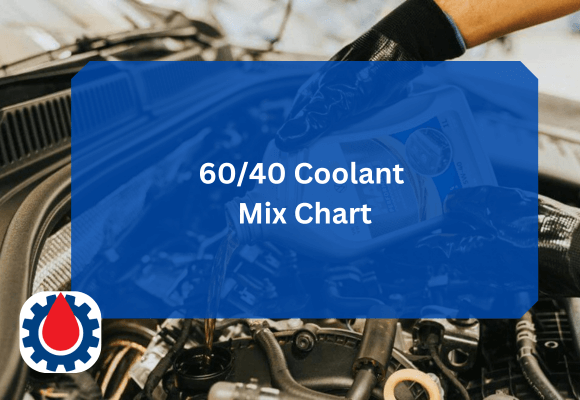When it comes to keeping your engine running smoothly and efficiently, the coolant mixture plays a vital role. A 60/40 coolant mix, which means 60% antifreeze and 40% distilled water, is one of the most reliable ratios for drivers who experience cold winters or hot summers.
Below, we’ll explain why a 60/40 ratio is ideal, how it compares to other mixtures, and provide a complete coolant mix chart that shows freezing and boiling points for different antifreeze concentrations.
60/40 Coolant Mix Chart
A 60/40 coolant mix refers to a blend of 60% antifreeze and 40% distilled water, and it’s considered one of the most effective ratios for protecting an engine in both extreme cold and high heat. The antifreeze component (usually ethylene glycol or propylene glycol) lowers the freezing point and raises the boiling point of the coolant, while the distilled water helps with efficient heat transfer.
| Antifreeze % | Water % | Freeze Protection °F | Freeze Protection °C | Boil Protection °F* | Boil Protection °C* | Recommended Use |
|---|---|---|---|---|---|---|
| 100% | 0% | +8°F | -13°C | 330°F | 166°C | Not recommended – poor heat transfer |
| 95% | 5% | -90°F | -68°C | 322°F | 161°C | Extreme cold – industrial or military vehicles |
| 90% | 10% | -84°F | -64°C | 314°F | 157°C | Extremely cold regions (rare use) |
| 85% | 15% | -76°F | -60°C | 310°F | 155°C | Severe arctic conditions |
| 80% | 20% | -62°F | -52°C | 308°F | 153°C | Very low temperatures |
| 75% | 25% | -64°F | -53°C | 304°F | 151°C | Subarctic conditions |
| 70% | 30% | -67°F | -55°C | 302°F | 150°C | Harsh winter climates |
| 65% | 35% | -63°F | -52°C | 285°F | 141°C | Cold regions and heavy-duty engines |
| 60% | 40% | -60°F | -51°C | 270°F | 132°C | Optimal all-season mix (recommended) |
| 55% | 45% | -47°F | -44°C | 268°F | 131°C | Slightly cold areas – good balance |
| 50% | 50% | -34°F | -37°C | 265°F | 129°C | Standard mix for most climates |
| 45% | 55% | -25°F | -32°C | 260°F | 127°C | Mildly cold environments |
| 40% | 60% | -12°F | -24°C | 255°F | 124°C | Warm regions only |
| 35% | 65% | -5°F | -21°C | 252°F | 122°C | Hot climate use – limited freeze protection |
| 30% | 70% | +3°F | -16°C | 250°F | 121°C | Mild climates; short-term operation |
| 25% | 75% | +10°F | -12°C | 245°F | 118°C | Warm weather or summer flushing mix |
| 20% | 80% | +15°F | -9°C | 240°F | 115°C | Short-term flushing only |
| 10% | 90% | +25°F | -4°C | 230°F | 110°C | Minimal protection – not recommended |
| 0% | 100% | 32°F | 0°C | 212°F | 100°C | Water only – no freeze or corrosion protection |
Note: Boil protection values assume a 15 psi radiator cap, typical of most modern automotive cooling systems.
Why the 60/40 Mix Works Best
The 60/40 coolant mix strikes the perfect balance between freezing protection, heat transfer efficiency, and corrosion prevention. Here’s why many mechanics and manufacturers recommend it for harsh or variable climates:
- Superior Freeze Protection: Keeps coolant liquid even in subzero conditions down to -60°F, preventing radiator and engine block cracking.
- High Boiling Point: Resists boil-over during summer or heavy towing, protecting from overheating.
- Improved Corrosion Resistance: Antifreeze contains inhibitors that prevent rust and electrolysis inside aluminum and iron parts.
- Stable pH Balance: Prevents acidic buildup that can damage gaskets and water pumps.
- Better Lubrication: Keeps seals and water pump bearings lubricated, extending system lifespan.
This makes it a preferred choice for diesel trucks, tractors, performance vehicles, and off-road equipment, where both freezing and overheating risks exist.
How to Mix 60/40 Coolant Correctly
To achieve the right mixture, always use distilled or deionized water, never tap water, as it contains minerals that can lead to scaling and corrosion.
Step-by-step mixing process:
- Get a clean container and measure 60% antifreeze and 40% distilled water by volume.
- Mix thoroughly before adding to your cooling system.
- If your vehicle already contains coolant, drain it first to avoid altering the concentration.
- After refilling, run the engine for 10–15 minutes with the heater on to circulate and remove air pockets.
For convenience, some brands like Prestone, Valvoline Zerex, and Peak Global offer pre-diluted 60/40 or 50/50 blends, ideal if you prefer not to mix manually.
Signs of an Incorrect Coolant Mixture
Using the wrong ratio can cause several problems:
- Too much antifreeze (70%+): Reduces heat transfer, leading to overheating.
- Too much water (below 40%): Increases corrosion and freezing risk.
- Milky or rusty coolant: Indicates contamination or chemical breakdown, time for a flush.
Checking with a coolant tester or refractometer helps ensure the correct mix ratio and freezing point protection.
Maintenance Tip
Flush and replace your coolant every 3–5 years or 30,000–60,000 miles, depending on the manufacturer’s recommendations. Always use a coolant type that matches your system’s material (green for conventional, orange/pink for OAT or HOAT).
FAQs
What is the ratio of coolant to 60/40?
A 60/40 coolant ratio means the mixture contains 60% antifreeze and 40% distilled water. This blend provides stronger freeze protection and a higher boiling point compared to a 50/50 mix, making it suitable for extreme temperature conditions.
Is 60/40 coolant better than 50/50?
Yes, a 60/40 coolant mix offers better protection in colder climates and slightly higher boiling resistance than a 50/50 blend. However, 50/50 is more common and sufficient for moderate climates, while 60/40 is preferred in regions with severe temperature extremes.
What is the best ratio for coolant mix?
The best coolant mix ratio depends on climate and vehicle requirements. For most vehicles, a 50/50 mix works well, balancing freeze and boil protection. In very cold or hot conditions, a 60/40 ratio is ideal, offering enhanced performance and corrosion resistance.
What temperature is 60/40 antifreeze good for?
A 60/40 antifreeze mix protects against freezing down to about -60°F (-51°C) and prevents boiling up to approximately 270°F (132°C) under a pressurized system, making it excellent for both extreme cold and high-heat environments.
How to mix undiluted coolant?
To make a 60/40 mix from undiluted coolant, combine 60% concentrated antifreeze with 40% distilled or deionized water. Always mix thoroughly before pouring it into the cooling system, and never use tap water since minerals can cause scaling and corrosion.
Will straight antifreeze cause overheating?
Yes, using straight antifreeze without water can lead to overheating because pure antifreeze does not transfer heat as effectively as a water mixture. It can also thicken in cold temperatures, reducing coolant flow and overall engine efficiency.
Final Thoughts
A 60/40 coolant mix provides the best protection for engines facing both extreme cold and high heat. It safeguards your radiator, water pump, and internal components against freezing, boiling, and corrosion. Whether you’re operating a pickup in Alaska, a tractor in the Midwest, or a performance car in the desert, maintaining this balance ensures long-term reliability and efficiency.
Regularly check coolant condition, verify the concentration with a tester, and top up only with the same mix ratio. Doing so keeps your cooling system in peak health and your engine running smoothly year-round.




